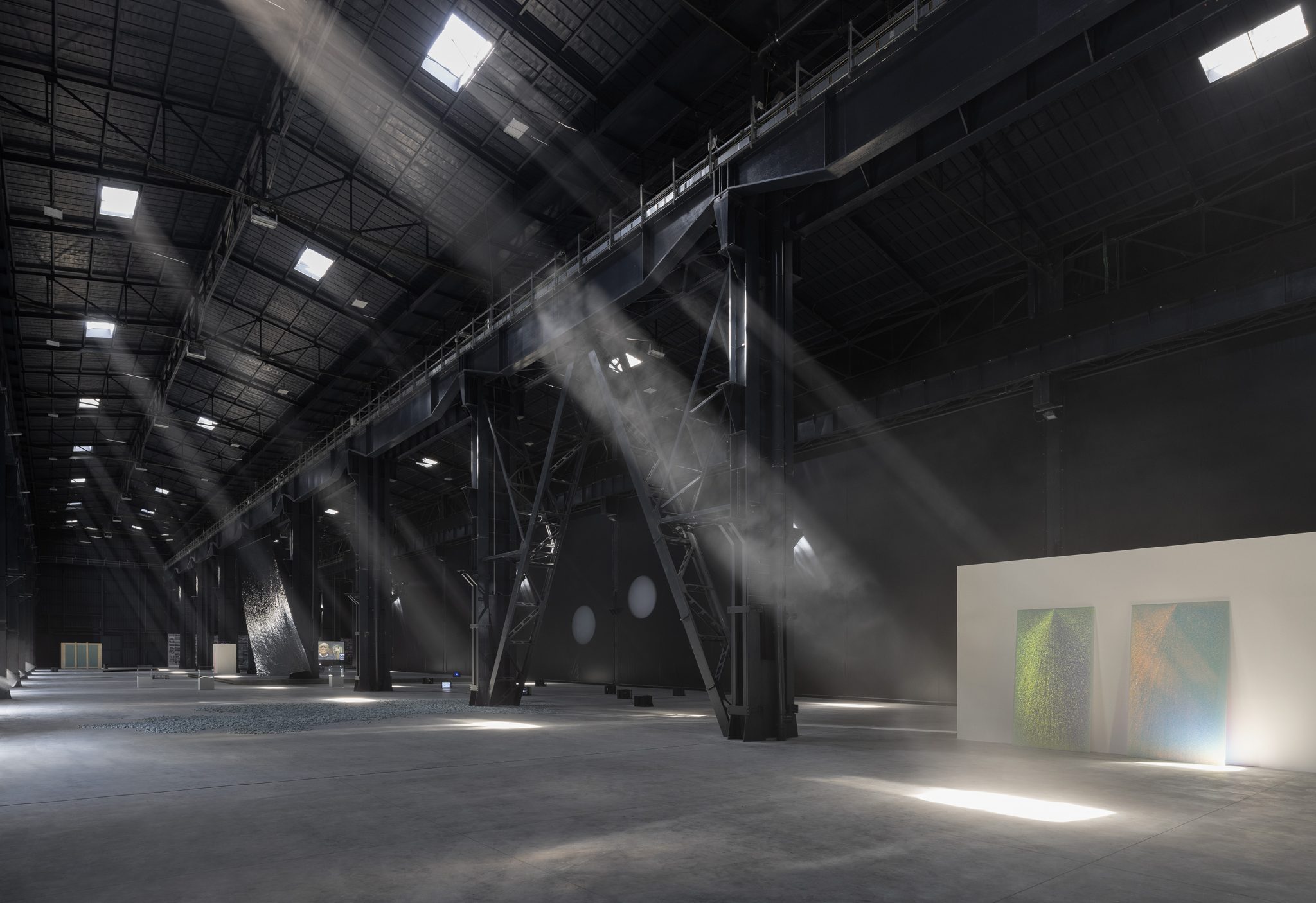A vast exhibition of the Belgian artist’s immersive work evokes the permeability of indoor and outdoor space through a focus on the fragility of the built environment
There is usually no natural illumination in the Navate, Pirelli Hangar Bicocca’s cavernous, 5,000sqm concrete-grey exhibition space. That’s no small hurdle when offering a career survey to Ann Veronica Janssens, whose practice often probes our relationship to natural phenomena, light in particular. Yet, perhaps because of this monochrome setting, Grand Bal works beautifully, the Belgian artist’s understated interventions disproportionately reframing the 1960s architecture. Makeshift skylights, fashioned by uncovering old fire and ventilation openings, bring daylight into the venue for once. When it’s sunny, heavenly beams function as a weightless light sculpture, a sundial of sorts – stay long enough and you see them flow across the space.
The first ‘real’ work we encounter is Drops (2023), a modular intervention consisting of large round mirrors on the floor. The almost enveloping darkness of the entrance makes the mirrors resemble deep pools of shadowy water or even mysterious portals into other worlds. If your knowledge of physics is rudimentary like mine, you will be amazed, peering into them, to find an abundance of light instead of darkness in the reflection, and instantly look up to find its source (the distant skylights!) – your firm belief in your own rational perception of the space instantly dispelled.

Further along, natural phenomena – sound, light, air, water (when it rains) – pour in through the eight hangar doors that punctuate one wall of the space, all left open for the show’s duration. They make up Waves (2023), a site-specific installation: each door is fitted with a double-layered mosquito net, hung from the top and falling to the ground like a curtain. When I visited in mid-April, a breeze intermittently rustled the nets, so that they danced in unison to wind and light, the undulating effect further enhanced by the overlaid nets’ shimmering moiré. From outside, birdsong, car noise and human chatter filtered in. By conferring materiality or focus on things architecture is designed to isolate us from, Janssens here nudges us to pause, observe and notice the world around us, like fluxing air or the playfulness of light.
Janssens’s interest in how we experience and perceive architecture, and the permeability of indoor and outdoor, is a common thread here, perhaps most evidently in Area (2023) and Swings (2000–23). Area extends over a large section of the Navate, forming a wobbly, concrete-brick structure that creates an elevated islandlike platform we are encouraged to walk on top of, especially if we want to access our inner child by swinging on the fantastically long Swings, hanging sturdily from the 30m ceiling high above, and feel the rush of air on our cheeks. The swings’ seats are covered in liquid-crystal film that reacts to body heat by changing colour, so that we leave a trace behind. If only for a moment.

Elsewhere, Janssens’s signature glass works feature prominently, including Untitled (2019–23), a rectangular sculpture of incredibly pristine optical glass, which, while reminiscent of a giant block of ice, puts everything in hyper-focus, like the best possible pair of glasses, and her glass and wood cases (Pink Coco Lopez and Yellow Yellow, both 2010), where the use of dichroic film makes us endlessly search for the source of colour refracted in the glass boxes, shifting from different angles as we walk closer. The artist’s fascination for the science behind things – glass casting, light, our senses – is evidently matched by her love of architecture, and for elevating and amplifying life’s seemingly mundane or overlooked corners. Some of Janssens’s most persuasive works are lesser-known, more personal pieces that offer clues to her own daily life: MUHKA, Antwerpen (1993–2023), for example, an ongoing black-and-white photographic series printed on copy paper that captures details of interior and exterior architecture from around the world, highlights her affinity for fragile, temporary or abandoned structures reclaimed by nature. Or the selection of videos playing on several CRT monitors, in which the mesmerising Eclipse videos (1999–2017) testify to Janssens’s avocation as avid eclipse-chaser, traversing the globe to witness and document these rare and discomfiting natural events.
The show concludes with MUHKA, Anvers (1997–2023), an unassuming door giving way to a vast square room – the Navate’s adjoining Cubo space – filled with a sea of white artificial fog. As I walked around blindly, my senses were on high alert, claustrophobia kicking in, until I found my way to the beyond – a wall of glass windows and, finally, the newly heightened beauty of daylight.
Grand Bal at Pirelli Hangar Bicocca, Milan, through 30 July
